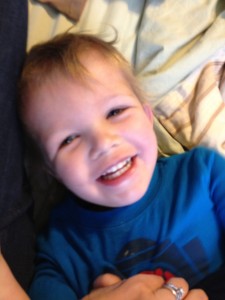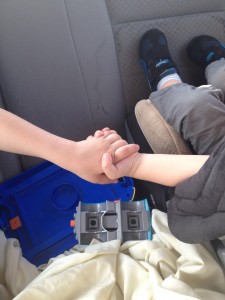I mentioned here when J was first diagnosed with childhood apraxia of speech that Mark and I were considering getting J an iPad with a speech app on it in order to help him communicate. However, the therapists here were against it, saying that he was too young and that it might discourage him from using his voice. I never felt quite comfortable with this though, and kept an ear out for research.
Enter the FB page of writer Robert Rummel-Hudson. He is an augmentative and alternative communication (AAC) advocate. His daughter, Schuyler, uses an AAC device as her primary means of speech. He posted a video of a child younger than J effectively using an iPad to talk, and then later on shared a blog post written by a speech therapist whose young child uses an iPad. (iPads are not the only type of AAC but due to the expense and bulk of other AAC devices, it is becoming perhaps the most popular one.) I started asking questions and ended up reaching out the to speech therapist directly.
Long story short, yesterday found J and I road-tripping 2.5 hours to meet with her for an evaluation. We started off using the LAMP app on the iPad. LAMP has 3 settings (they correspond to amount of words available to the user) and we started on the middle. I was surprised at how quickly J picked it up. Pretty soon we’d moved on to allowing him to use the full version of the app. The highlight was watching J use the program to label colors. He’d click the color button, then choose a color, which the program would say out loud. Then, he’d point to that color somewhere in the room, thus proving he knew what he was saying with the machine. J can not name any colors with his voice, nor have I seen him do well at picking out colors when requested. With the iPad though, he was correctly labeling them about 80% of the time. The therapist also explained that kids who use AAC do not become dependent on it; research is actually showing that some of them speak earlier than those kids with the same diagnosis who do not use AAC.
We left with the recommendation to get J an iPad or iPad mini, along with the LAMP program. I immediately started looking for grants online. An iPad mini is $329 and LAMP is $299, so obviously this is not an inexpensive venture. We missed a few of the grant cycles by a matter of weeks, so I’m looking for agencies that award them more frequently than quarterly so we do not have to wait until August for J to be able to take advantage of this technology. However, many of the grant applications I came across required a letter from the speech therapist, which meant I’d have to “fess up” to our local therapist about what we’d decided to do.
This morning was J’s weekly therapy appointment. Now, I like this therapist. She has little experience with verbal apraxia but has been willing to learn, and J likes her so that is good enough for me right now. I hoped that she’d be on board with our plan even though initially she’d expressed reluctance. As she worked with him on vocalizing “open,” I explained that PECS was not working for us. It felt like a step backward. The therapist agreed. Then I just dove into explaining that we’d gone in for an AAC eval, that it had gone well, and that we were pursuing grant money. She was enthusiastic, and went and got an iPad with LAMP on it so J could demonstrate what he’d learned.
His therapist started by asking him to tell her which color block he’d like. He correctly requested all the blocks in the pile. Then she showed him a stuffed red fruit.
“What is this?” she asked.
Understand that is not a question that J can answer verbally. His words basically consist of yah, no, hi/bye, more, go, uh-oh, and ew, and whether he is able to access these words on any given day is anyone’s guess, as part of verbal apraxia is that the ability to say a particular word comes and goes.
J pushed the eat button, which opened up a food screen. He selected fruits, then clicked tomato. “Tomato” the iPad said. Then, with no prompting, he found the word for like, and then grocery store, to tell us that he likes tomatoes and gets them at the grocery store. I had to rub my eyes to push back happy-sad tears: happy that he can communicate so well with an AAC and sad that there is so much he wants to say and can not right now.
Obviously J isn’t using this perfectly right now, but he’s doing a great job. His therapist agreed to write a letter on our behalf in order to secure funding for him. My hope is that we get the funding quickly so J can get communicating better quickly!



